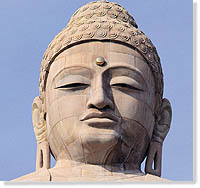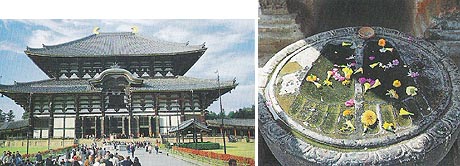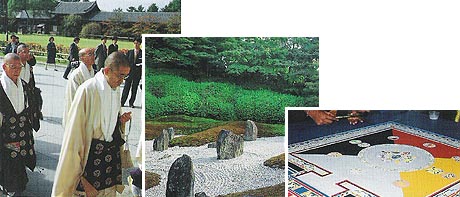.
 Buddhism Buddhism
It has often
been asserted that Buddhism is not really a religion but a philosophy.
However, Buddhism is not a philosophy. It is a religion; it is
a doctrine of liberation and a way to liberation.
And in fact
the Buddha understood himself as something like a doctor who wanted
to help suffering people to find liberation and redemption. However,
everyone had to try out the means of healing for themselves.
Here, the
Buddha was something like a present-day psychotherapist who helps
people to overcome crises in life, to understand the causes of
suffering and so cope with it, to be content with their limitations,
finitude and mortality. But the Buddha was more than a psychotherapist.
He was more radical. He himself had experienced Enlightenment
that human beings, if they see through everything, could recognize
that all that they see is not stable, that nothing in the world
is permanent. Everything is changeable; even the self, to which
we so cling, basically has no abiding substance, but is just as
transitory.
So the suffering
from which human beings are to be cured is this illusion of a
real self. Human beings are to learn through the therapy of the
Buddha to free themselves from their own selves.
They are
to find the way from a concern with the self and entanglement
in the self to a selflessness which makes them free for an all-embracing
compassion.

From
left: Todaji temple, Nara; Stone footprint of Buddha, Bodh-Gaya,
India..
The
teachings of Buddha
Buddhism
had its historical origin in the sixth century BC with Siddharta
Gautama.
In the Four
Noble Truths, he taught insight into the cause of human suffering
and with the Eightfold Path showed a way towards overcoming it.
Through this
insight, Siddharta Gautama became the Buddha, the Enlightened
One. Buddhists do not understand the Ultimate Reality, the Absolute,
as a personal deity or a creator God, but as the impersonal dharma,
i.e. the eternal law which rules the universe and which is the
subject of the teachings of the Buddha.
Buddha’s
teachings were gathered together over a long period; the most
important are the Theravada canon (Tripitaka) and
the Mahayana sutras.
There are
more than 300 million Buddhists worldwide, divided into the two
big schools of Theravada (Doctrine of the Elders), mainly
practised in Sri Lanka, Myanmar, Thailand, Cambodia and Laos,
and Mahayana (Great Vehicle), mainly practised in China,
Korea, Japan and Vietnam as well as in Tibet and Mongolia (Vajrayana:
Diamond Vehicle).

From
left: Buddhist monks at the autumn feast in Nara; Simplicity and
transparency: a Zen garden.

|

